What is a 1-3-1 Press Defense?
A 1-3-1 Press is a 1-3-1 defense just extended up the floor. The 5 same spots of the half-court defense remain the same. This makes it a good press to drop straight back into the 1-3-1 half-court defense. The 1-3-1 press has one player usually at the foul line or 3-point line. Three players at the half-court line of the court. This can be in front of, on, or behind the half-court line. It just depends on how far the press is going to extend. And one player as the back player usually around the defending basket foul line or 3-point line.
The 1-3-1 press takes the rotations of the 1-3-1 half-court trap and extends it into a press. This gives a defense the ability to learn 1 defense and use it in multiple instances. The press tries to get the ball to the sideline and then traps it with the point and wing. This can be done all the way up the floor, but I personally like to trap in this press one time when the offense crosses the half-court line. This reduces the amount of space each wing must cover in dropping on the backside and uses the half-court line as a 3rd defender.
Advantages of a 1-3-1 Press Defense
1. Easily transitions from press to half-court
A good press defense must be able to transition quickly from the press into the half-court defense. The slower this switch is, the more likely the offense can get a good shot during the transition phase. The 1-3-1 press can be designed so the players are all in their half-court positions just extended up into a full-court setting. This means all the defense has to do to go from press to half-court defense is drop back. This reduces the amount of time the offense has to attack during this transition phase.
The transition is simple so is should not be difficult for the players to learn how to go from press to half-court. The easier things are for the players, the less they have to think, and the faster they can play. A player who has to think about what to do and where to go is going to make them a second or two slower than just reacting to the game. These split seconds can be the difference between getting a good closeout and leaving enough space for the offensive player to shoot.
2. Keeps the ball out of the middle
The 1-3-1 press keeps a player in the middle of the zone press. This player can prevent the offense from using the middle of the floor to help break the press. This forces the offense to keep the ball on the sideline where the press is trying to trap. So, the offense is forced to put the ball in the spot where the defense is wanting the ball to go so the defense can get a trap on the ball.
The more active the middleman can be in the 1-3-1 press, the better the press is going to work. If the middle man allows the ball into the middle, then the press is going to break down. The press is not designed for the ball to be in the middle, so when this happens the defense can be unsure of how to react, and the rotations can get confused letting the offense get an easy basket.
3. Slows the offense down
The 1-3-1 press can be used in multiple ways. The first is by trapping and forcing turnovers. The second is slowing the offense down and preventing the ability of the offense to run a transition offense. The 3 defenders lined up across the floor creates a natural wall which forces the offensive players to pass the ball. If a player tries to dribble through a 1-3-1 press, then the player usually turns the ball over.
When an opponent has a very good player in the open floor, the 1-3-1 press can be used as a counter to this player. When this happens, the defense is not looking to get traps but looking to slow the offense down and not let the offensive player to play in open space. They will be forced to stop and potentially pass the ball which can be a win for the defense. If the best player is forced to pass the ball, then they have less of a chance to score baskets. The potential to change the pace of the game by slowing the opponent down offensively can keep an up-tempo transition offensive team from getting those easy buckets.
Disadvantages of a 1-3-1 Press Defense
1. Susceptible to long passes
The 1-3-1 press can be beat with both up the sideline passes as well as long diagonal passes. This is based on bad rotations by the defense.
If the back defender does not rotate completely to the ballside sideline, then the offense can make an up the sideline pass getting the ball past the front four defenders. This can lead to the back defender having to guard a 2 or 3 on 1 scenario.
If the backside wing does not drop in the press, then the offense can make the long diagonal pass which could lead to an easy layup. While this long diagonal pass is hard to make, it can beat the press almost single handily.
2. Wings must be disciplined
In the 1-3-1 press, the key rotations are the two wings working in unison with each other. As one wing comes up, the other must drop back. The wings must be up when the ball is on their side to get a trap. If the wing is not there, then the trap is not able to occur.
However, the backside wing must drop back because they are the rim protection. If the backside wing does not drop, then the offense will be able to attack the basket with no defenders there. The wings must be disciplined in their movement during the press. They have to sprint on each and every pass. Bad wing discipline leaves too many open spaces and traps either not taking place or being in the wrong spots.
3. Need a size advantage to really execute well
A 1-3-1 press can be used with any team but a team with a size disadvantage can struggle to get good traps. That is because the 1-3-1 press is a little cat and mouse game at half-court. The ability to restrict vision with a defense’s size helps to improve the ability to get a good trap. If an offensive player can not see over a defender, then they can not make that next pass.
When a defense comes up to get a trap, the offensive player should be looking to make a pass out of the trap before the trap gets to them. If a defense is shorter than the offense, then the offense can see the next pass and make it before the trap. However, if the defense is taller, then the offense is less likely to see and make the next pass. This gives the defense the time they need to really set a good trap. While a team can run a 1-3-1 press with a size disadvantage, it might be a better idea to use a different press when a defense is shorter.
Positions of a 1-3-1 Press Defense
The positions of a 1-3-1 press defense is the same as the half-court 1-3-1 defense. The defense should transition straight from the press to the half-court. As a coach and team, the personnel of the half-court 1-3-1 should stay the same for the press. This is because the press should just be the half-court defense extended up the floor into a press.
This usually means the biggest player is in the middle of the zone. The fastest player is on the bottom of the 1-3-1. The tallest player is on the point. And the two smartest players on the team are the wings.
Depending on the players, a team may not be able to have the exact player in the right spot. This is when a decision about which spot on the 1-3-1 is the most important or which spot is the one to sacrifice with a less than ideal player. For instance, the point may be a shorter player because the smartest players are also the tallest. This means those two are on the wings making the decision when to trap. Do not be afraid to change positions if something is not working.
Trapping in a 1-3-1 Press
The 1-3-1 press is a one trap press. It is designed to slow the offense down and force the ball into one spot on the floor. Once the ball enters that spot, the defense traps it. If the ball does not enter that spot or a pass is made out of the trap, then the press falls back into a half-court defense. The players are not going to be running all over the place trying to trap.
Trying to trap in a 1-3-1 press becomes a game with the offense within the actual basketball game. The offense knows where the defense wants the ball to go and the defense knows the offense does not want to put the ball in that spot. Every possession of the press is a battle to see if the defense can force the ball into a trap or if the offense can keep the ball out of a trap zone.
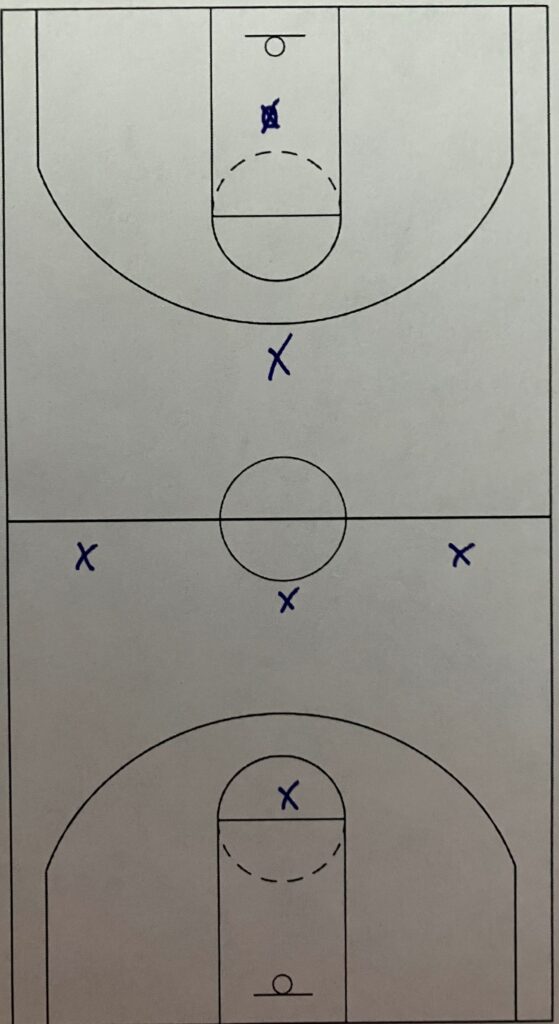
This is the initial setup of the 1-3-1 press. The point is somewhere between the half-court line and 3-point line. The middle is on the backside of the circle. The two wings are a step or two behind the half-court line. And the back player is around the 3-point line to foul line depending on if the offense sends anybody all the way down the court or not.
The press is inviting the offense to cross half-court. The press is not a very aggressive press. It wants to invite the offense to dribble up the floor. Hopefully the offense dribbles past half-court and at that point the defense gets the trap and by the time the offense knows what is happening, the defense has a trap forcing a bad pass and a steal.
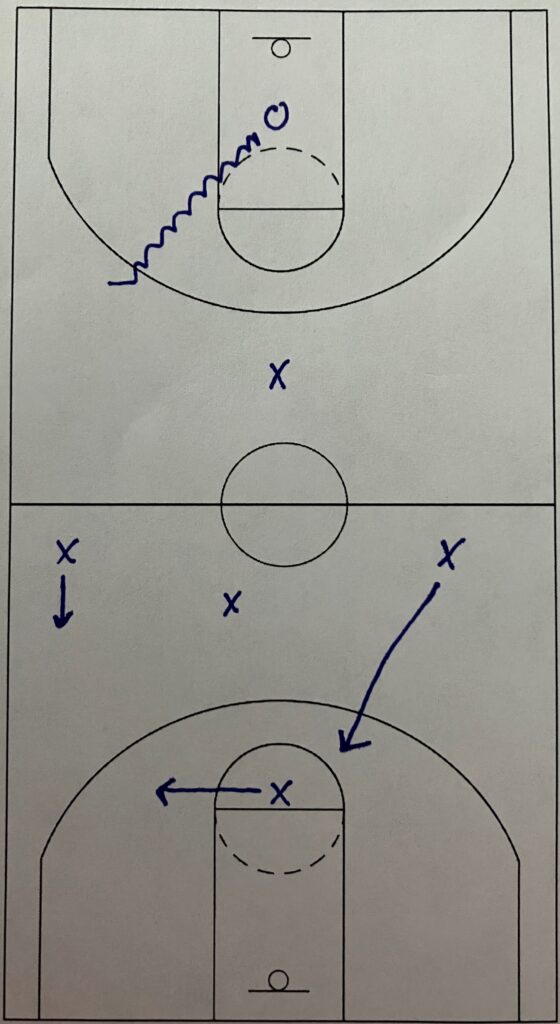
The key to the 1-3-1 press is getting the ball to a sideline. It does not matter which sideline. I am just going to show a rotation on one sideline but everything just reverses for the other side. The point of the press is going to force the ball to one side or the other. The middle is taking away a pass or a player in the middle of the zone. The ballside wing is actually dropping a step or two away from the ball. They are trying to show the dribbler that there is more free room for them to keep coming up the floor. The backside wing is dropping to the back of the press. This is normally the 3-point line area but it can be farther if the offense has players at the basket. The bottom player is rotating towards the ball. The general rule of thumb is for the bottom player of the press to be in a vertical line with the ball.
The hardest part of the press is right here in this spot. The ballside wing has to appear to be dropping clearing space for the dribbler to continue coming up the floor. As they are dropping, they need to be patient and not rush up too soon. If they rush the ball handler too early then the half-court line does not become an extra defender.
The middle, bottom, and backside wing are reading the ballside wing as when to rush and take away the next pass. This is where the two wings must be smart players. At this point in the press, everybody on defense is watching and waiting on the ballside wing to move. As soon as they move to trap, every defender must move with them. One defender not moving with the ballside wing will leave an open pass to the offense.
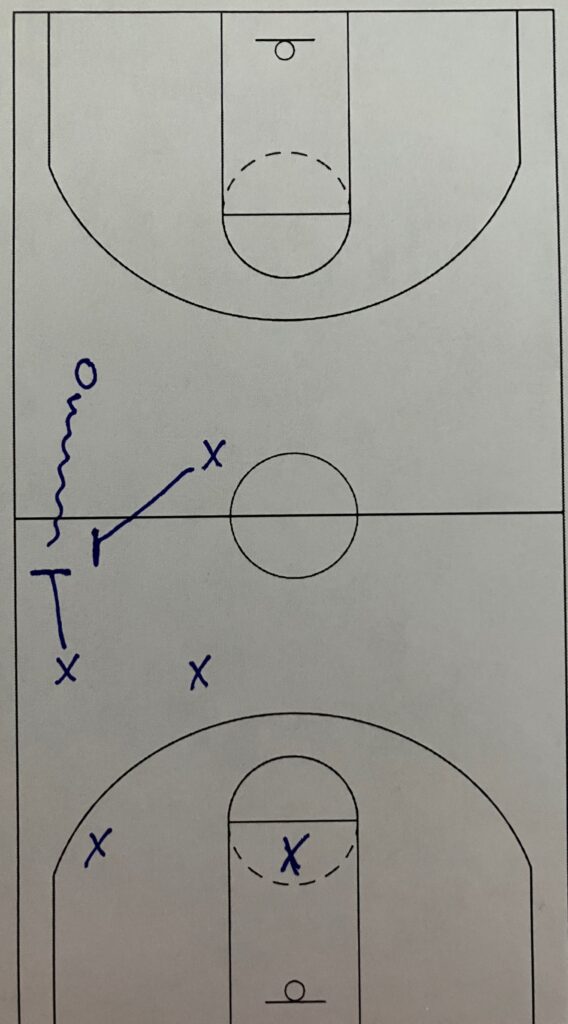
As soon as the ball crosses half-court, the ballside wing and point rush to trap. The middle player is taking away any offensive player in this area. The middle player can be all the way up to half-court during some traps. The bottom player has rotated to the sideline. They are taking away any pass that could come from the trap up the sideline. The backside wing has rotated back to the foul line area or lower if necessary. They are now the final rim protector.
The best case scenario is the offensive player sees the trap coming too late and makes a quick pass. The middle and bottom defenders are rotating into positions as the trap is starting. The quick pass is stolen by either the middle defender or the bottom defender jumping the passing lanes on their rotations.
If the trap gets set well and the middle and bottom defenders rotate to the next pass, then sometimes the offensive player will throw a long pass over the top of the defense. The backside wing should be in a position to steal any pass like this. A good trap in the 1-3-1 press usually leads to a turnover or at minimum a deflection out of bounds. But getting the offense to continue dribbling the ball into the trap zones in the corner of half-court and the sideline is hard. After a couple of traps, the offense knows what is happening and tries to keep the ball out of these two spots.
Skip Pass Rotation
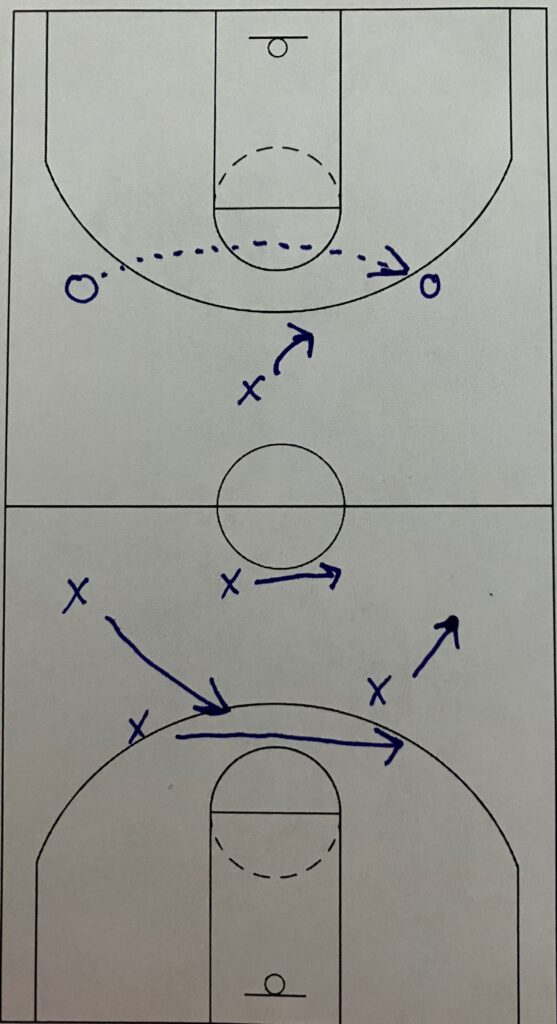
The skip pass will be used by an offense to try and avoid a trap. The defense rotates in the 1-3-1 press just like the 1-3-1 half-court defense. They are going to travel farther to get into the right spots but everything else is the same.
The point is now going to force the ball down the sideline it is on. The middle player moves across the midline. They are taking away any offensive player in the middle of the zone. The bottom player is sprinting across the floor to get back in line with the ball. The wings are basically switching spots. The left wing is dropping back to be the potential rim protector. The right wing is coming up waiting for the ball to cross half-court to rush and trap.
Teams will start to throw skip passes back and forth to change the defense before trying to get across half-court. A good point will get steals if possible or at least make the skip pass travel up in the air high enough to give the other 4 defenders time to get into their new spots.
When an offense starts doing this, then they are going to rush the ball across half-court closer to the middle of the floor. As long as the wings are in good position they can trap with the point as soon as the ball crosses half-court. It will not be as good as trapping on the sideline, but a trap can still cause turnovers using the half-court line as a third defender.
Keys of the 1-3-1 Press
1) Wing Discipline
The wings must be disciplined in dropping when the ball is opposite. An undisciplined wing can give up the long diagonal pass for a layup if they are not dropping. A non-dropping backside wing will prevent the 1-3-1 press from even being able to get into a trap because the long diagonal pass can be made before crossing half-court.
The backside wing is going to be the rim protection in most cases. The two wings are not normally rim protectors, so they need to stay disciplined in staying back and not gamble up for a steal. Any gamble by the backside wing is an automatic layup for the offense. The press wants to be aggressive in trying to trap but the last line of defense needs to be cautious. In a 1-3-1 press this responsibility is on the wings. Half the time they need to be up trapping and the other half the time they need to be back protecting the rim. The wings must be disciplined and understand the difference in when to be aggressive and when to be cautious.
2) Not Rushing the Trap
The 1-3-1 press is designed to get one good trap right when the offense crosses half-court. The timing to get this trap must be exact. Trapping too early gives the offense the ability to back dribble away from half-court. Trapping to late gives the offense too much space between them and half-court to back dribble and pass out of the trap. A trap at the exact right moment gives the defense the sideline and half-court line as two extra defenders leaving the offense no where to go.
The wings must give space to the offense until they rush the trap. If the space is not there, then the offense will not enter the trap zone. If the wings give too much space, then the offensive player can dribble through the trap zone. The balance between giving enough space but not giving too much space is hard for some players. This is why the two wings need to be the smartest players on the court because they have to understand the cat and mouse game of getting the ball into the trap zone but not letting it out.
When I am installing the 1-3-1 press the majority of practicing the press is on timing the trap just right. I use different drills to help the players understand when to rush and trap and when to wait. I also need the point player to be in sync with the wings so the two trapping players commit to the trap at the exact same moment. For me, I usually only run the 1-3-1 press with a point and wings that can work in unison. If the point and wings cannot get their timing together, then I will use a different press.
3) Everybody Moves at Once on the Trap
The trap needs to wait until the offense puts the ball in the right spot. Then the two trapping players must move to trap together. The other 3 defenders must see the trapping players go and react immediately. The 3 non-trapping players must be in the right spots to prevent an easy pass out of the trap. If the 3 non-trapping players do not move with the trapping players, then the offense has easy passes to the middle or up the sideline to get the ball out of the trap. The players all moving together can create bad passes because the offense sees an open pass that goes away on the defensive move. By the time the offense realizes the pass is bad, the ball is already out of their hands.
Youth Basketball and the 1-3-1 Press
The 1-3-1 press is a good press for youth basketball. The rotations of the press are the same as the 1-3-1 half-court zone defense. The players learning the 1-3-1 press at the youth level is going to help them improve the press as they get older. The 1-3-1 half-court zone defense and 1-3-1 press rotations are the same for the younger grades as they are in high school.
Some defenses and presses do not translate well from the youth level up into high school. Presses that work at the youth level due to the chaotic nature of the press do not work when the players improve as they age. There should be learning done at the youth level that translates to improved ability and skill at the high school level and beyond.
The 1-3-1 press taught at the high school level is the same press taught at the youth level. The biggest difference in the two age groups is the speed and knowledge of the players. The 1-3-1 press will continue to get better as the players keep growing. Some presses that work well at the youth level do not translate to older players, but this is not a problem with the 1-3-1 press.
Conclusion
The 1-3-1 press is a great addition to any defensive playbook and game plan. When the 1-3-1 press is run correctly, it presents a challenge for any offense. The hardest part of running a 1-3-1 press is knowing when to use it. Using it with the wrong team or wrong type of players can give the offense an advantage.
Anytime I have a team that is able to run a half-court 1-3-1, then I am also installing the 1-3-1 press. The rotations are all the same between the press and half-court. The difference is the amount of space being covered with each rotation. Essentially it is one defensive install to get two different zone defenses.
However, if I have a team that is unable to or just not the right personnel to run a half-court 1-3-1, then I will not use the 1-3-1 press. Just because the 1-3-1 press works with one team or one season does not mean it is going to work year after year. Teams change each and every year. When a team is able to run a 1-3-1 press, then it works great. When a team cannot execute a 1-3-1 press, then the offense can attack the press easily. A team and coach has to be self-aware and understand if they do or do not have a team that is suited for the 1-3-1.


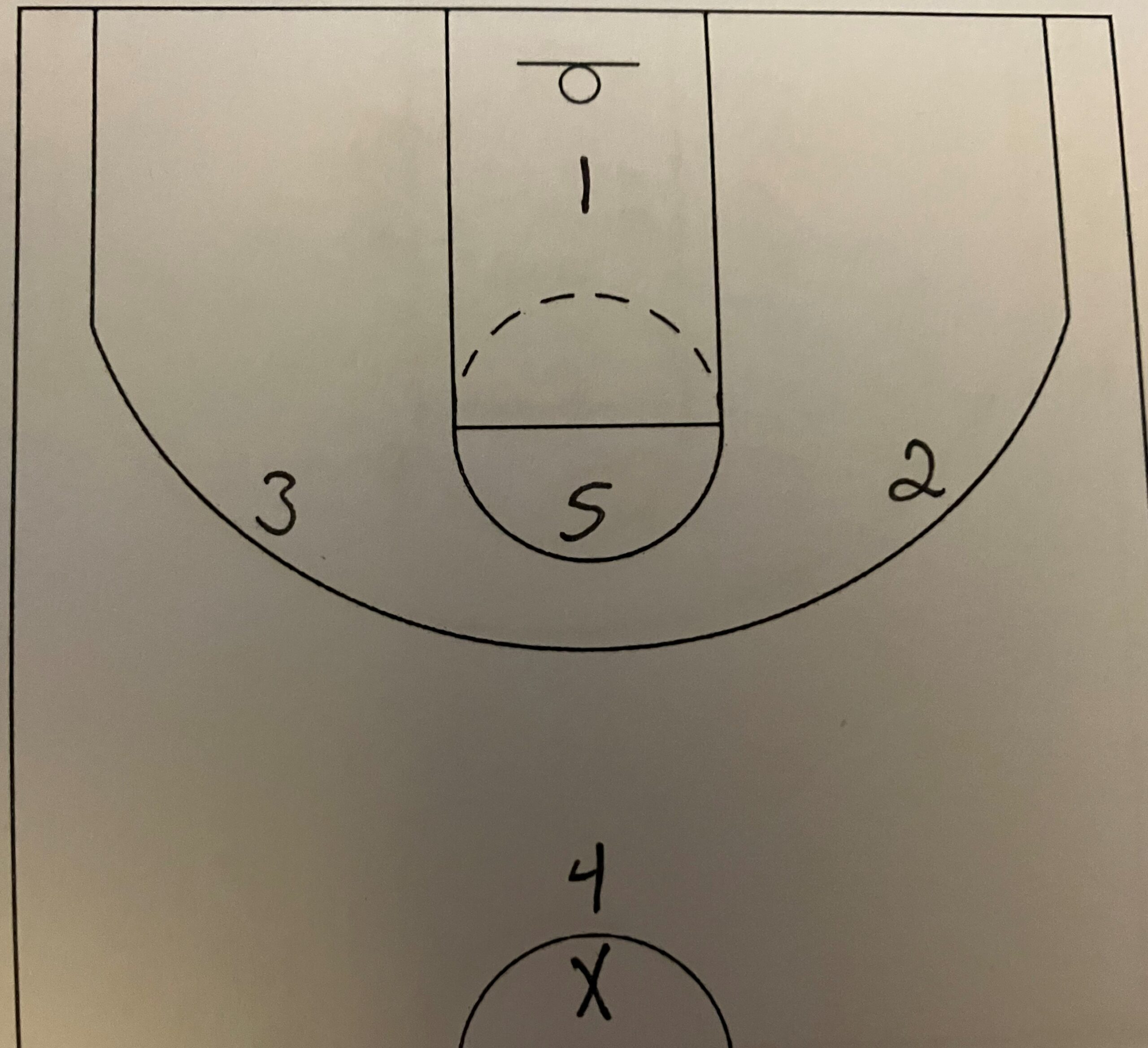
6 thoughts on “1-3-1 Press Defense”